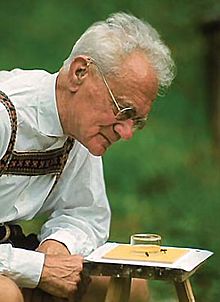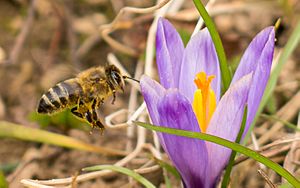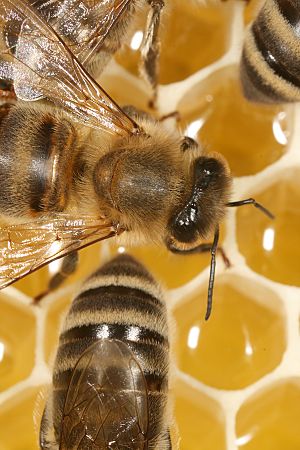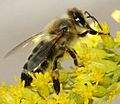Karl von Frisch facts for kids
Quick facts for kids
Karl von Frisch
|
|
|---|---|

In traditional dress, with his honey bees
|
|
| Born | 20 November 1886 |
| Died | 12 June 1982 (aged 95) |
| Nationality | Austria |
| Known for | Bees |
| Awards |
|
| Scientific career | |
| Fields | Ethology |
| Signature | |
 |
|
Karl von Frisch (born November 20, 1886 – died June 12, 1982) was an Austrian scientist. He studied animal behavior, especially how animals communicate. In 1973, he won the Nobel Prize in Physiology or Medicine. He shared this award with two other scientists, Nikolaas Tinbergen and Konrad Lorenz.
Karl von Frisch spent most of his life studying honey bees. He was one of the first people to understand the famous "waggle dance" of bees. This dance is how bees tell each other where to find food. At first, some scientists didn't believe his ideas. But later, his research was proven to be very accurate.
Contents
Early Life and Education
Karl von Frisch was born in Vienna, Austria. His father was a surgeon. Karl was the youngest of four brothers, and all of them became university professors.
He first studied medicine in Vienna and Munich. But soon, he changed his focus to the natural sciences. He earned his doctorate degree in 1910. Right after that, he started working at the University of Munich.
Career and Challenges
In 1912, Karl von Frisch became a lecturer in zoology. He was promoted to a professor in 1919. His important research on honeybees continued.
During the Second World War, Karl von Frisch faced difficulties. The Nazi government didn't like some of his choices. For example, he hired Jewish assistants, including many women. His scientific ideas were also called "Jewish science." He was even forced to retire for a short time. However, his crucial research on bee diseases helped him get his job back.
Sadly, his zoology institute was destroyed during the war. In 1946, he moved to the University of Graz to continue his work. He returned to Munich in 1950 when the institute reopened. He officially retired in 1958 but kept doing his research.
Personal Life
Karl von Frisch was married to Margarete Mohr. She passed away in 1964. Their son, Otto von Frisch, also became a scientist. He was the director of a natural history museum for many years.
Discoveries About Bees
Frisch studied many things about how animals behave. He focused on the Carniolan honey bee, which is a type of European honey bee. He wanted to understand how bees find their way around and how they communicate.
How Bees Sense the World
Frisch found out that bees can tell different flowers apart by their smell. He also discovered that bees can taste "sweet" things, but their sense of taste is only a little better than ours.
One of his most important discoveries was in 1914. He showed that honey bees can see colors! Before him, people didn't know that.
He also learned how bees find their way. Bees can use three different ways to know which direction to fly:
- They use the sun as their main compass.
- They can use the pattern of light in the blue sky (called polarization).
- They can even use the Earth's magnetic field.
These other methods help them when the sky is cloudy or inside their dark beehive.
Bees also have an amazing internal clock. They can remember when and where they found food in the morning. Then, they can go back to the same spot at the right time in the afternoon, using the sun's new position.
Bee Dances: Their Special Language
Bees have a special way to tell other bees about good feeding places. They do this by performing unique dances. There are two main types of dances:
The Round Dance
The "round dance" tells other bees that there is food very close to the hive. This food is usually within 50 to 100 meters (about 160 to 330 feet). This dance doesn't tell the exact direction. But by touching the dancing bee, other bees can smell what kind of food it is.
The Waggle Dance

The "waggle dance" is used for food sources that are farther away. When a bee does this dance, it moves in a figure-eight pattern on the honeycomb. The most important part is the straight line in the middle.
- Direction: The direction of this straight line tells other bees the direction of the food. The angle of the straight line compared to straight up (the top of the hive) is the same angle that the food source is from the sun.
- Distance: The length of time the bee "waggles" its body during the straight part tells the distance. For example, one second of waggling means the food is about one kilometer (0.6 miles) away.
Other bees follow the dancing bee very closely to learn this information. They also use their sense of smell to know what kind of food (nectar, pollen, water) is available. This communication is so good that bees can find food even if they have to fly around obstacles like a mountain!
Frisch thought bees might sense vibrations during the waggle dance, even if they didn't "hear" in the same way humans do. Later research confirmed that bees do use vibrations for communication.
Other Bee Discoveries
Karl von Frisch also studied special chemicals called pheromones. Queen bees and their daughters release these chemicals. Pheromones help keep the bee colony organized. Outside the hive, these smells attract male bees (called drones) to the queen for mating. Inside the hive, the drones are not affected by the smell.
Awards and Recognition
Karl von Frisch received many awards for his important work:
- Lieben Prize (1921)
- Pour le Mérite for Arts and Sciences (1952)
- He became a Foreign Member of the Royal Society in 1954.
- Kalinga Prize for making science popular (1958)
- Balzan Prize for Biology (1962) – for discovering the bee's language.
- Nobel Prize in Physiology or Medicine (1973) – for his work on animal behavior and insect communication.
- Grand Merit Cross with Star and Sash of the Federal Republic of Germany (1974)
- Bavarian Maximilian Order for Science and Art (1981)
In his honor, the Karl Ritter von Frisch Medal is given out every two years. It is Germany's most important science prize in zoology.
Images for kids
-
Carniolan honey bee on a goldenrod flower head
See also
 In Spanish: Karl von Frisch para niños
In Spanish: Karl von Frisch para niños






